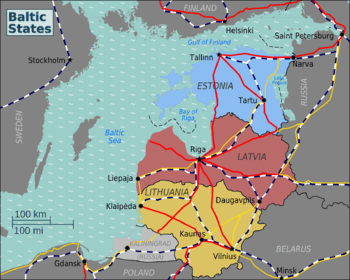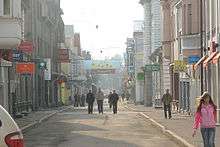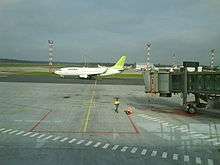Baltic states
The Baltic states are three countries of north-eastern Europe, on the eastern shore of the Baltic Sea. The three small countries have a long interesting history, and an impressive cultural heritage dating back to the Hanseatic League. The region's 175,015 km2 are home to 6.3 million people, nearly half of them in Lithuania.
Countries
North to south:

| Estonia The most Nordic of the three Baltic countries, with linguistic connections to Finland. |
| Latvia A predominately Protestant country, with a lot of Baltic-German and Nordic heritage. |
| Lithuania An expanding economic market, it has some of the best natural countryside in Europe. |
Other regions
Kaliningrad – a bizarre small slice of Russia between Lithuania and Poland that makes for an interesting addition to a Baltic trip. Entering the exclave requires a Russian visa.
Cities
Capitals
_(7670904378).jpg)
The three capitals all have UNESCO-listed old towns, Soviet concrete new towns and occasional 21st century buildings in between.
The cities are roughly listed North to South
Other
The towns and cities are roughly listed North to South
- 🌍 Tartu – Estonia's second city with a relaxed student vibe
- 🌍 Daugavpils – second biggest city of Latvia
- 🌍 Liepāja – Latvian beach city known for its music and the former secret Soviet military town of Karosta
- 🌍 Kaunas – second biggest city of Lithuania, with an old town and many museums and galleries
- 🌍 Klaipėda – Lithuania's harbor city - belonging to Germany until World War I under the name "Memel" and still served by Baltic Sea Ferries from German ports
- 🌍 Šiauliai – Lithuanian city with odd specialist museums and the Hill of Crosses
Other destinations

- 🌍 Saaremaa – largest Estonian island, green landscapes dotted with quaint villages and a medieval castle
- 🌍 Jūrmala – Latvian resort town on the Baltic Sea; draws a crowd in summer for the long stretch of sandy beach and cool forests
- 🌍 Curonian Spit - a sandy spit containing the largest drifting sand dunes in Europe, at the border of Lithuania and Kaliningrad Oblast
Understand
Baltic States are diverse, and each country and region has a different history and culture. While Latvia and Estonia were under foreign dominance for centuries, Lithuania was one of major powers in the region. The culture of Baltic states was strongly influenced by Scandinavians, Germans, Poles and Russians. Modern history of the Baltic States has been especially shaped by various forms of Russia, since it gained control over the area during the 18th century. People of Baltic States have strong national identities, and are today well-integrated with the Western world.
History
The Baltic states have had vibrant histories. Christianity, Germans and feudalism arrived together in the 13th century. Also in the 13th century, the Grand Duchy of Lithuania emerged as a major political player in Medieval Europe. The Hanseatic League dominated commerce on the Baltic, until Denmark and later Sweden came to rule the Sea.
In the 16th century, the Polish-Lithuanian Commonwealth took over control of the area. It lasted until the late 18th century. The area of the Baltic states was then largely absorbed into the Russian Empire, with a slice of modern-day Lithuania being given to Prussia.
As part of revolutionary Russia's speedy exit from the World War I in 1918, the early Soviet government relinquished claim on the region, creating the states which exist today. Prussia was also considerably reduced after the war.
The Soviet Union rebounded and re-annexed all three states during World War II in a move greatly resented by their populations. The Nazis used anti-Soviet sentiment to help them form Baltic auxiliary police units that assisted the Nazis in wiping out almost all of the area's Jewish population (see Holocaust remembrance) and others considered ethnic or ideological enemies (notably including Poles), though the Nazis' claims to being liberators were not widely believed for long. The Soviets yet again annexed the Baltics in 1944, in a move condemned as illegal in the West but tolerated as part of the emerging Cold War diplomacy. In 1990–91, the Baltic states led the breaking away of the USSR's constituent republics from the central government. They all turned away from Moscow and all joined both the European Union and NATO in 2004. All Baltic states are members of the Eurozone with Lithuania being the last to do so in 2015.
The Baltic States have seen rapid economic growth since their independence; while hit hard by the 2008 financial crisis, they are now recovering. In 2017, the United Nations Statistics department changed categorization of the Baltic States from eastern Europe to northern Europe.
Kaliningrad, subject of ethnic cleansing and repopulated by Russians loyal to Moscow, became an exclave of Russia after the fall of the USSR.
Religion
Traditional Christian affiliations were Lutheranism in much of Latvia and Estonia, and Catholicism in Eastern Latvia and Lithuania. Communism and the general loss of religion across the Western world have heavily altered the traditional affiliations: Once a Lutheran country, Estonia is now among the least religious countries in the world, as 49% say they have no belief in God, and a further 40 claiming to be either agnostic or not being affiliated with any religion; in Lithuania, 49% say they do, and Catholicism remains a vital life force in everyday life; Latvia is evenly split between Lutherans, Orthodox (mostly among the Russian community), and irreligious. A smattering of pagan belief persists, for example the Romuva faith, perhaps because this was one of the last areas of Europe to be Christianized.
Talk

Each of the three countries has its own language, with Russian as a common second, or even first, language of many, particularly in the cities. English is widely spoken, especially among younger people and academics; those born after the fall of the Soviet Union tend to be fluent, especially in Estonia. German is often understood and spoken at a conversational level. Any attempt to speak the native language is greatly appreciated.
The Estonian language's similarities with Finnish, along with Finnish cultural influences, allow much mutual comprehension. In Tallinn Finnish is spoken or understood at most places of interest for the average visitor. Some Polish is spoken in Lithuania.
Given that Russian was the language of the perceived colonial oppressor, it may not be well received. Try first communicating in the native language or in English, at least for greetings and to ask whether the person prefers to speak Russian. The negative attitude towards Russian tends to persist in Estonia and Latvia, with Lithuania having less anti-Russian language sentiment.
Latvian and Lithuanian are related to each other as Indo-European Baltic languages. It is commonly believed that Baltic and Slavic languages are more closely related to one another than other branches of the Indo-European language family, but this is not even yet the unanimous opinion of linguists and unlikely to be of much help understanding people or recognizing cognates. Estonian is relatively closely related to the Finnish language, much more distantly related to Hungarian (about as close as Spanish and Greek are) and not related to the Baltic languages or any other Indo-European language even though there are of course loanwords.
Get in
All three states are part of Europe's Schengen area.
By plane

Generally speaking there are fairly good connections from other parts of Europe and from the western half of the former Soviet Union. Save for a few exceptions, getting to the Baltics from elsewhere always includes at least one change of planes.
Riga Airport (RIX IATA) in Latvia is by a large margin the busiest airport in the Baltic countries. It is the main hub of AirBaltic, which flies to around 60 European cities (including most major cities) and has seasonal routes to the Middle East and Central Asia. When flying to the Baltic states, chances are you will pass by Riga.
Tallinn Airport (TLL IATA) in Estonia is a small airport with far fewer direct connections than its neighbors. However, it ranks among the best airports in the world for its excellent service, modern facilities, and customer service. Most flights go to Helsinki, Frankfurt, Riga, Warsaw, London, and Scandinavia.
Vilnius Airport (VNO IATA) in Lithuania is best served by budget airlines Wizz Air and Ryanair, though a number of major carriers can be found as well. Ryanair also provides several connections to Kaunas Airport (KUN IATA). Palanga Airport serves as a small regional airport for the western part of Lithuania with a few routes.
By boat
Ferries criss-cross the Baltic. A popular route is Helsinki–Tallinn. There are also many Baltic cruises.
By train
Rail connections are pretty shoddy, not to say awful and even not recommended. Vilnius is the entry hub for rail travelers from Warsaw, Kaliningrad and Belarus. All three capitals have at least daily connection to Moscow and St Petersburg. Note that the trains from Vilnius to Moscow and from Kaliningrad to St Petersburg via Vilnius (do not confuse with direct train form Vilnius to St Petersburg) pass through Belarus, which might require an additional visa.
Get around
By plane
The capitals are all connected to each other by short flights. From Riga there are flights to Kaunas and Palanga. From Tallinn there are flights to Tartu, Kuressaare and Kärdla.
By bus
The international bus network is pretty well developed making for easy movement. Bus is in most cases the fastest and most practical way for intercity travel if you don't have a car.
By train
None of the capitals have direct services between them, though each country has a usable and cheap domestic network. Riga to Tallinn can be traveled by train in one day by changing in Valga. Riga to Vilnius requires an overnight stop in Daugavpils.
By bicycle
The international bicycle project, BaltiCCycle may provide you with a lot of information and help.
By car
- See also: Via Baltica
Your own car or a rented one is also an option, especially if you want to get to places outside major cities. Large highways are in a good shape and almost comparable to the ones in the Nordic countries, sideways and streets (in particular in smaller towns) much less so.
See
- The Baltic sea coast with sandy beaches, including the Curonian Spit
- Some of Europe's lowest "highest country points"; Suur Munamägi (318 m) near Võru, southeast Estonia, Gaiziņkalns (312 m) near Madona, central Latvia and Aukštojas (294 m) southeast Lithuania near the Belarusian border.
- World heritage listed old towns in all three capitals.
- Buildings and other remains from the Soviet Union.
- The Hill of Crosses near Siauliai
Itineraries
- Via Baltica - goes from the Estonian capital Tallinn through Riga, Latvia and Kaunas, Lithuania and continues to Warsaw, Poland.
- Cruising the Baltic Sea
Do
Eat
The Baltic cuisine has similarities with the Nordic, Russian, and Central European cuisines. They have a wide range of bread, eaten to nearly every dish. The most traditional alcoholic beverages are beer and vodka, though kvass (a beverage commonly made from rye bread) is also common.
Drink
Owning to their geography and history, the Baltic States are fond of hard liquors and beer. Another common drink in the area is Kvass.
Stay safe
Unlike their giant next-door neighbor to the east and several other former Soviet Republics, the Baltic states have never dealt with rampant criminality, nor have they been regarded as dangerous places. They are usually very safe countries, and taking the basic precautions will suffice to feel comfortable. Nevertheless, some issues do remain and may require your attention.
- The Baltic States suffer from rampant alcohol-related problems. Watch out for people who cannot control themselves, especially in nightclubs and rougher neighborhoods. Bouncers in the region have very low tolerance on the matter and, if need be, will resort to violence to get rid of drunkards.
- Violent crimes such as aggravated assaults have occurred, but are usually limited to poor towns and neighborhoods that are located off the beaten track. The town of Narva in Estonia, the western parts of Riga, and the northern neighborhoods of Vilnius are some notable examples.
- In Riga and Tallinn, the Russian mafia remains very much present.
- Open homosexuality is rare in the region, and same-sex couples will often be met with glaring stares, but violent reactions are unlikely.
Go next
Stay on the Baltic coast with:
- Gdansk - historic Prussian port town, later home of the Polish movement Solidarity, which helped bring down communism
- Helsinki - enter the Nordic countries via the charming Finnish capital
- Stockholm - easily reachable by ferry and plane, Sweden's capital is another excellent entry point to Scandinavia
- Kaliningrad - estranged former Soviet brother of the Baltics, Russia's westernmost outpost
- St Petersburg - a prettier way to see Russia than Kaliningrad
Or head inland to:
- Minsk - see Stalinist architecture of the 1950s at its best
- Moscow - Russia's capital is the world's northernmost city with more than 10 million inhabitants, and has a lot to see and do
- Warsaw - vibrant cultural life and good dining